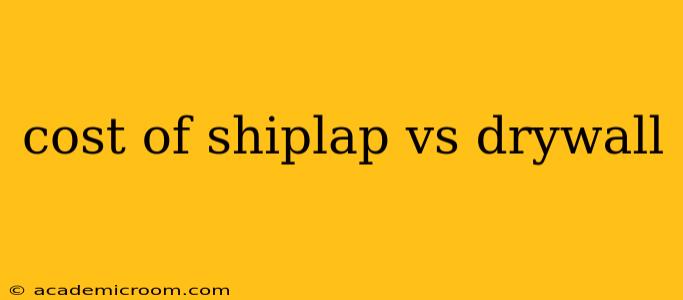Choosing between shiplap and drywall for your walls can significantly impact your budget. While both offer distinct aesthetic and functional benefits, understanding the cost differences is crucial for informed decision-making. This detailed comparison explores the factors affecting the price of each material, helping you determine which option best suits your project and budget.
What Factors Influence the Cost of Shiplap?
The cost of shiplap varies based on several key factors:
- Material: Real wood shiplap, typically pine, cedar, or reclaimed wood, is generally more expensive than engineered wood or MDF (medium-density fiberboard) alternatives. Reclaimed wood, due to its unique character and limited supply, commands the highest prices.
- Thickness: Thicker shiplap boards are typically more expensive than thinner ones.
- Width: Wider shiplap boards often cost more per linear foot than narrower boards.
- Grade: Higher-grade shiplap with fewer knots and imperfections costs more.
- Installation: Professional installation adds significantly to the overall cost, especially for complex projects involving intricate designs or difficult-to-access areas. DIY installation can save money, but requires time and skill.
- Finishing: The choice of stain, paint, or sealant influences the final cost.
What Factors Influence the Cost of Drywall?
Drywall costs are determined by several factors:
- Type: Standard drywall is generally the most affordable. Moisture-resistant drywall (for bathrooms and kitchens) and fire-resistant drywall (for specific areas) cost more.
- Thickness: Thicker drywall is usually more expensive.
- Size: Larger sheets are typically more economical than smaller ones due to reduced installation time and material waste.
- Installation: Professional installation is the largest cost driver, including the cost of labor, materials like tape and compound, and any additional finishing work.
How Much Does Shiplap Cost?
The cost of shiplap can range from roughly $3 to $15 per square foot, depending on the factors mentioned above. Engineered wood or MDF alternatives generally fall on the lower end of this range, while high-quality real wood shiplap can reach the higher end, particularly with reclaimed materials. Remember that this cost only includes the material; labor costs for installation can add significantly more.
How Much Does Drywall Cost?
Drywall typically costs between $1 to $3 per square foot for the material itself. Again, this is just for the drywall sheets; the cost of installation, including labor, materials like tape and mud, and any necessary finishing work, will drastically increase the overall cost. This installation cost can be comparable to, or even exceed, the cost of the drywall itself.
Shiplap vs. Drywall: Which is Cheaper?
In terms of material cost alone, drywall is considerably cheaper than shiplap. However, the total project cost, including installation, can significantly alter this comparison. A simple drywall installation might be significantly less expensive than a complex shiplap installation. Factors like the size of the area, complexity of the design, and the need for additional finishing touches can greatly influence the overall cost.
What are the differences in installation costs between shiplap and drywall?
Drywall installation is generally faster and requires less specialized skill than shiplap installation, potentially leading to lower labor costs. Shiplap requires more precise cutting and fitting, which can increase labor costs, especially for intricate patterns.
What are the pros and cons of each material?
Shiplap:
- Pros: Aesthetically pleasing, adds rustic charm or modern farmhouse style, relatively easy DIY installation (for basic applications).
- Cons: Can be more expensive than drywall, may require more maintenance (depending on the material and finish), less durable than drywall in some cases.
Drywall:
- Pros: Cost-effective, readily available, durable, easy to repair, provides a smooth, clean finish.
- Cons: Can be less visually interesting than shiplap, requires more skill for smooth finishing, less forgiving of imperfections.
Is shiplap a good investment for increasing home value?
Shiplap can increase your home's value if it complements the overall style and enhances the appeal of the space. However, it's crucial to consider the overall design and target market. Overdoing shiplap or using it inappropriately can diminish the home's value.
By carefully considering these factors and weighing the pros and cons of each material, you can make an informed decision that best balances your budget and design preferences. Remember to obtain multiple quotes from contractors for both shiplap and drywall installation to get a clear picture of the total project cost.
